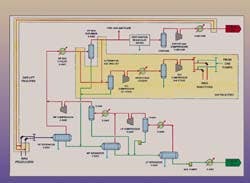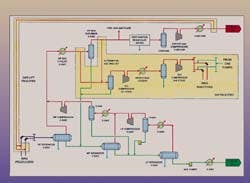Water Alternating Gas injection to lift Miller output by 6%
Neil Potter
Contributing Editor
Schematic of the Miller Field associated gas injection facilities.
BP is engaged in two major Water Alternating Gas (WAG) reinjection projects: one for the Miller Field in the UK sector, and the other for Ula in Norwegian waters. But the motives differ. For Miller, the aim is to recover an additional 9-18MM bbl of oil and extend the field life by up to two years: it was originally expected to wind down in 2002. On Ula, it was a question of what to do with the gas when the existing gas export route, via Phillips' Cod installation to Ekofisk, ends on October 1 next year.
"The Miller AGI (associated gas injection) is the UK's first approved miscible gas injection EOR project that had been wholly justified on the basis of incremental recovery," said BP Scotland director and general manager Greg Bourne at a UK DTI best practice IOR conference.
When BP submitted the original Annex B for the Miller development, it included a commitment to evaluate gas injection before the end of 1994. This was performed and reported to the DTI.
Oil production began in June 1992 with first gas in July the following year. The reservoir is an upper Jurassic submarine-fan sandstone formation lying 4,000 meters below the seabed. Recoverable oil reserves were originally estimated at 265MM bbl (since upgraded) with 420 bcf of associated gas. From the outset the reservoir has required an unusually high amount of water injection, up to 330,000 b/d. The gas has high H2S and CO2 content.
The reservoir contains some 500MM bbl. Calculations had shown that 48% - 282MM bbl - would be recovered through normal production methods over the field's lifetime. With incremental waterflooding an extra 4% would be collected, and with AGI as well, a further 2%. The total now recoverable (54%) is still 6% below the target set teams by John Browne, when he was chief executive of BP Exploration.
The Miller reserves recovery strategy is essentially based on initial line drive with waterflood in the south-east of the field, achieving voidage replacement at an early stage to maintain production potential and sweep. The flood is then developed field-wide into a peripheral waterflood, thereby optimizing field production and reserves.
Waterflood recovery efficiency is expected to be high based on the excellent injection performance since field start-up. Additional recovery will come from increased efficiency of the waterflood process and exploitation of the tertiary AGI recovery processed. The AGI scheme complements other envisioned Miller IOR schemes such as infill drilling, artificial lift and blowdown.
BP committed itself to the project formally in March 1995. The Asset Engineering Alliance, a partnering arrangement between BP and Wood Group Engineering, was assigned the work. An integrated project team was created that included Sulzer, ABB Cape, the Health & Safety Executive and Lloyds. The scheme, directed at the core south-eastern area of the field, is based on water alternating gas, in which water and gas are alternately injected into specific wells as part of a planned injection cycle.
Originally, six water injectors on the periphery of the reservoir drove the oil towards the centre of the field. As the water reaches the central area, gas will be injected to sweep up oil that has not been cleared by water injection. Gas lift will be used in wells in the centre of the reservoir.
The £17.9 million (excluding gas well workovers) project involves the installation of a new centrifugal two-stage compressor using gas seals, and associated pipework on the platform. Four wells, A01-4, will be converted to WAG injection with gas lift of two producers.
The four wells will operate as two water and two gas on a 3:3 month cycle. Water will be injected at 55,000 b/d maximum and gas at 80 mcf/d at 50bar per well. The two gas lift wells (WAG producers) will be supplied from the export compressor discharge. In future, full field gas lift up to 10 wells could be accommodated. Early 1997 was the original target to commence gas reinjection. But this has been brought forward to October 1997.
The process skids with two scrubbers and heat exchangers were fabricated by Wood Group. The skids went offshore mid-May in two 28 tonne sections on a supply boat and were lifted on by the platform crane. The compressor package went offshore at the end of June.
Miller export gas, currently 234 mcf/d, is contracted to the Peterhead power station, north of Aberdeen.
Sulzer (UK) supplied the turbo-compressor package, which comprises two Sulzer Turbo types RB28-5, made in Zurich, with a gear box-driven motor.
Copyright 1996 Offshore. All Rights Reserved.

